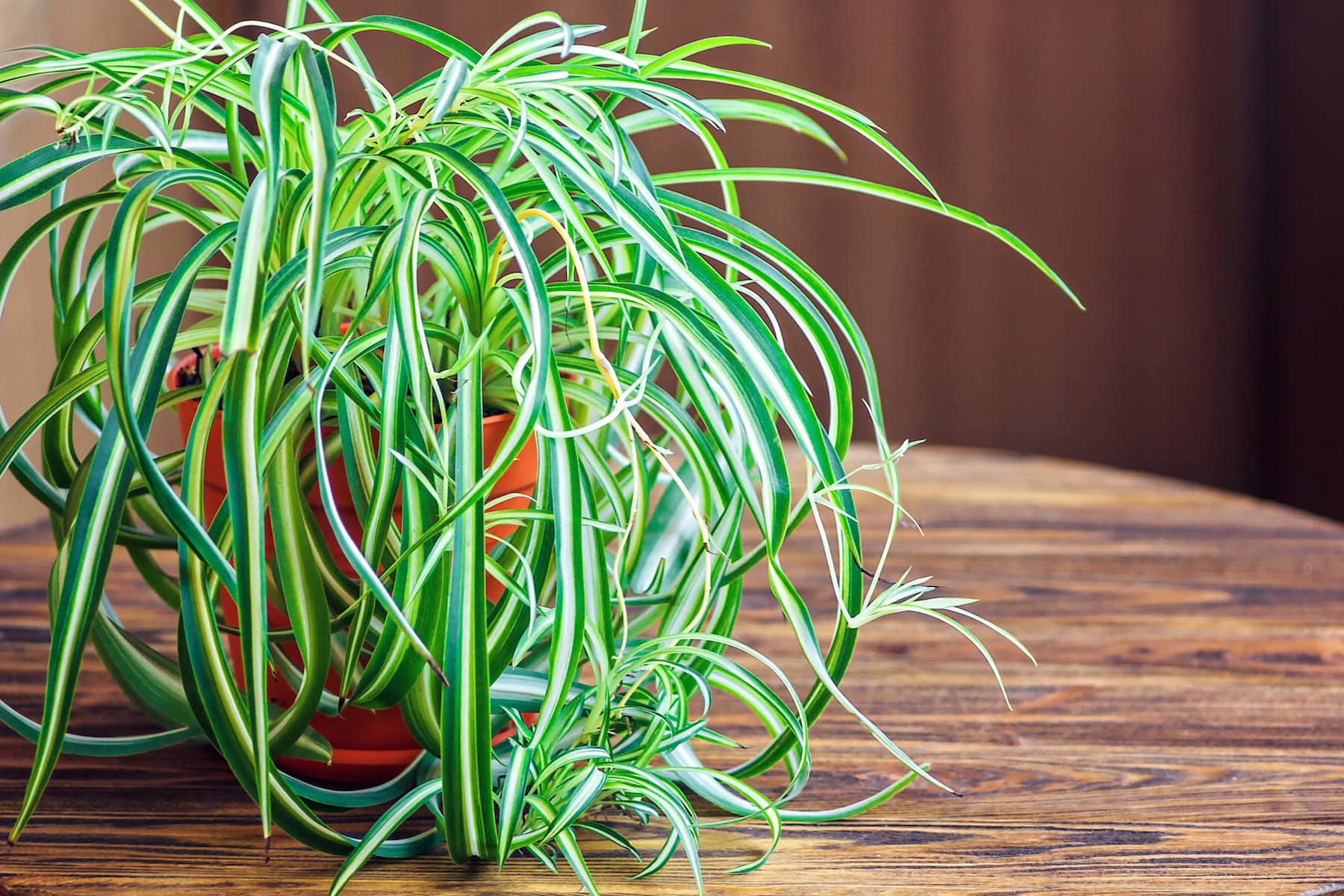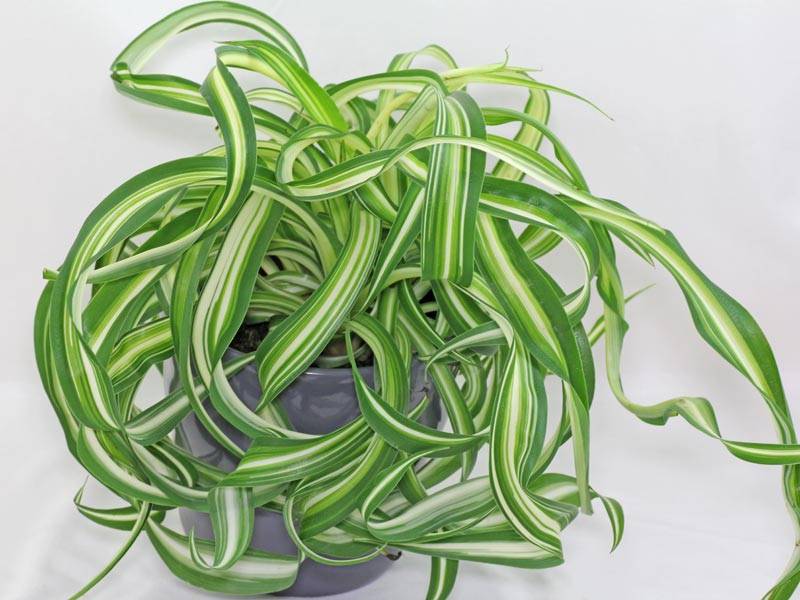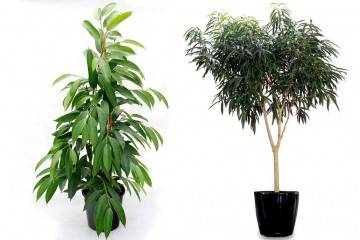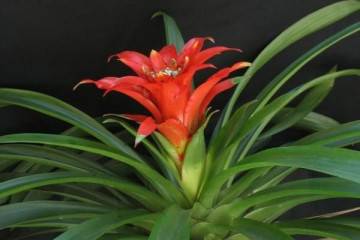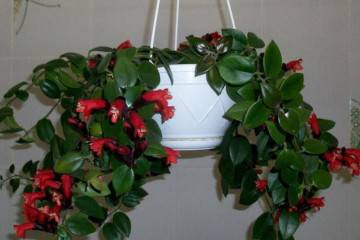Chlorophytum flower - home care
Content:
Unpretentious and hardy - this is how each owner characterizes chlorophytum. A minimum of effort, and a lush bush will grow in the pot. Valuable qualities - the ability to endure strong shading without harm to appearance, can stand for several weeks without watering and not die. A real must-have for the office!
What does chlorophytum look like?
The herbaceous plant chlorophytum is a flower that traditionally belongs to the Liliaceae family, but some botanical catalogs include it in the Asparagales family. Long linear leaves are collected in powerful basal bundles. Small flowers blooming on very long (up to 1.5 m and more) peduncles form a loose brush. On the same peduncles, after the flowers have faded, babies are formed - bunches of leaves with air roots.
 What does chlorophytum look like with babies
What does chlorophytum look like with babies
Chlorophytum is prized as a plant that absorbs large amounts of carbon dioxide. It absorbs carbon monoxide, acetone, nicotine and formaldehyde from the air. In the kitchen, as well as in smoking rooms, he is perhaps the only one capable of not only surviving, but also improving the atmosphere.
For the first time, mention of an inhabitant of the South African subtropics in historical chronicles was discovered in 1794. Some of the species are native to South America. Today, on all continents, the flower is grown in homes and offices, appreciating for its unpretentiousness and ability to heal the atmosphere. The name translated from Latin means "green plant", which exactly corresponds to its appearance.
Common varieties
In flower shops, there are many varieties of chlorophytum, differing in the habit and color of the leaves. They all have similar content requirements.
Crested
The leaf is long, narrow, of emerald color. The center of the leaf plate has one or more longitudinal white stripes. The arrow grows 80-100 cm long, at the end of which 5-7 white flowers bloom.
Curly
The variety is often referred to as Bonnie. Leaves are up to 60 cm in length, and only 3 cm in width. Dense basal rosettes are formed from leaf plates that bend as they grow like curls. Unlike other varieties, this one does not drive out long peduncles, they are short and numerous. The plant is propagated by dividing the bush.
Kapsky
External differences from curly are in the size of the leaves, which stretch up to 100 cm in length. He also does not drive out long arrows with children. The mother plant is propagated only by dividing the bush.
Orchidostellar
It is also called orange or winged. The leaf is wide, elliptical, but also pointed at the end. The height of the bush is about 40 cm. The leaf petiole is very fleshy and is colored bright orange, like the central vein. The most contrasting color is in young leaves, and the old ones gradually become completely green. On short peduncles, inflorescences of flowers, similar in shape to an ear, bloom. Children grow at the base of the bush.
Chlorophytum: home care
The most inexperienced grower can be recommended to start breeding indoor plants with chlorophytum. It is very difficult to bring him to death, because the bush survives even in the harsh conditions of public institutions.
Temperature
Changes in temperature in the house have practically no effect on the appearance and vitality of the plant, but up to a certain limit. A decrease below 16 ° C is a threshold, after which the plant stops growing. He is most comfortable at 20-22 ° C, but heat up to 35 ° C will not cause death.
Lighting
Shade tolerance allows chlorophytum to be placed in dimly lit places: on cabinets, in walls, on refrigerators, etc. Too bright sunlight can leave ugly burns on the leaves. On the northern windows, the plant will not experience stress from the scorching sun, but it will also grow slowly. Oriental and western window sills are ideal.
Watering
For irrigation, they take settled water, either at room temperature, or a little cooler. The plant can withstand up to 2 weeks without watering, but it will look frankly pathetic: the leaves will turn pale and sluggish. Due to its ability to collect dust, the flower is recommended to be bathed under a weak pressure of water as it gets dirty.
The recommended watering regime in summer is every other day or every 3 days. In winter, watering is much less frequent - only 1-2 times a week. The top layer of the soil must necessarily dry out, and the main earthy lump should remain slightly moist. Water is poured along the edge of the pot, being careful not to fall into the center of the leaf outlets.
Spraying
The standard room humidity of about 60% is quite suitable for the flower. Even drier air will not cause significant damage for a long time. In spring, weekly spraying with a fine spray is recommended. In hot weather above 30 ° C, spraying can be carried out every day.
 Chlorophytum spraying can be done daily
Chlorophytum spraying can be done daily
If the heat in summer is above 30 ° C, then every week it is recommended to bathe the flower under a slightly cool shower. Water that has fallen into the points of growth is gently blotted with paper napkins.
Humidity
Indoors, chlorophytum works like a real humidifier, intensively evaporating water from its leaves. This is a very valuable quality for people with lung disease. It is known that one plant significantly humidifies the air in an area of up to 2 m² around it. Because of this, he does not need to artificially increase the air humidity, but it is necessary to compensate for the loss of moisture.
Chlorophytum primer
There are no special requirements for the soil, most importantly, it must be moisture and air permeable. A light, pH neutral substrate with a high content of sand, peat and humus is ideal.
If you want to prepare the substrate yourself, and not use a ready-made one from the store, then the recommended composition is as follows:
- leaf land - 2 parts;
- sod land - 2 parts;
- humus - 1 part;
- sand or perlite - 1 part.
Top dressing
The need for fertilizers is moderate. It is recommended to apply top dressing from May to October, when the plant is actively growing. Twice a month, the bush is watered with liquid fertilizer for deciduous plants. Organic beneficial dressings should be alternated with mineral ones. The concentration of the solutions must be kept slightly more liquid than the manufacturer recommends, and only the moist soil in the pot must be watered.
Features of winter care
In winter, it is worth keeping the temperature at the same level as in summer - about 18-20 ° C. The plant dies when it drops to 8 ° C. Spraying in winter is not recommended, even if the air becomes dry due to heating. It is better to arrange a shower for the flower 2 times a month.
Pruning
No shaping is required for the rosettes. From time to time, you need to remove dried or broken leaves.In some varieties, numerous daughter rosettes grow next to the mother plant. But there is no particular need to remove them, since with them the bush only becomes more luxuriant and more beautiful, which is another purpose of them.
Chlorophytum transplant
It is usually held in the spring. Young plants are transferred to new slightly large pots every year, and adults every 2-3 years. The signal is usually the emergence of roots from the bottom of the pot. The new container should be 2 cm higher and 5 cm wider. Be sure to cover the bottom with a layer of large drainage (pebbles or expanded clay).
When and how it blooms
The flowering of chlorophytum is very modest and is not a valuable quality. Cute little star flowers only look good with exceptional grooming. If the peduncles do not appear, then this indicates that the plant is too young or it is very cramped in the pot.
 Chlorophytum flower does not cause sympathy among florists
Chlorophytum flower does not cause sympathy among florists
The flowers are simple white up to 2 cm in diameter with five petals and six long stamens with yellow anthers at the tips. The second variety is an ear up to 5-7 cm long, found in orange-leaved varieties, dotted with the same small white or yellowish flowers.
Flowering period
If the pot is large enough, the plant gets enough light, then new arrows with buds will appear regularly, regardless of how many are already on the bush. One arrow blooms for about a month. After the last bud withers, young rosettes of leaves will begin to grow at the ends. At this time, if there is no desire to propagate the bush, then the peduncle is carefully cut off at the base. But many people prefer to leave them, finding in this the special charm of the plant.
How to propagate chlorophytum
The simplest breeding methods are by children and by dividing the bush. The seed method is the most laborious and rarely used.
Germinating seeds
Seed germination rate is about 30%. They are sown in spring, pre-soaking in gauze for a day. The seeds should be planted in a sandy-peat substrate, 5-7 mm deep. Then cover with foil. The greenhouse should be placed in a bright and warm place, where the temperature is 22-25 ° C). The film is opened daily to ventilate and moisten the soil from the spray bottle. Seedlings will appear in 4-6 weeks.
Seedlings are opened gradually. First, for half an hour a day, gradually increasing the time interval. Seedlings should be planted in individual pots in the phase of 2-3 true leaves.
Rooting cuttings
In the spring, they traditionally try to transplant the flower into larger pots, and the overgrown bushes are divided into 2-3 parts. It is necessary to remove the plant from the pot, shake off the soil from the roots. Next, cut the root ball in half with a sharp knife, sprinkling the cut with crushed activated carbon. Each cut is planted in a separate pot with fresh substrate. Watering is recommended to be resumed only after a day.
Air layering
A baby suitable for transplant is about 6-7 cm in size. Usually by this time it has several air roots. The rosette is cut from the peduncle and planted in a pot with a loose substrate. No greenhouse needed. They are looked after in the same way as for adult plants. To grow the roots, you can hold the shoot in a glass of water for some time.
 Planting baby chlorophytum should not be difficult.
Planting baby chlorophytum should not be difficult.
It is perfectly acceptable to root the rosettes without separating them from the peduncle, simply by placing a small pot next to a large one. As soon as the young leaves begin to grow, the peduncle can be cut off.
Possible growing problems and diseases
It is extremely rare for chlorophytum to cause concern to the owner if all the recommended agricultural techniques are followed.
- Drops buds and leaves. This happens due to a lack of food. This means the pot has become too cramped, and it's time to transplant the plant into a more spacious container.
- The leaves turn pale.This happens due to the excess and lack of light, as well as due to the lack of nutrients in a cramped pot. It is necessary to transplant the flower and rearrange it to a more suitable place with diffused but bright enough light.
- The tips of the leaves dry. This is the first signal that the room is too hot. At such a time, chlorophytum needs to be sprayed, and it is also bathed in the shower under a weak pressure of water so as not to break fragile leaves.
- The lower leaves fall off. This is the natural process of growing a rosette. Dry leaves must be carefully removed. If too many leaves dry out, then it's time for a transplant.
Pests
The greatest damage to the plant can be caused by:
- mealybug. Its appearance is signaled by a white, very similar to cotton wool, bloom on the leaves. They fight against the pest of actara, biotlin. Treatments are carried out after 7 days 2-3 times;
- aphid. She is attracted by tender young leaves. The appearance of aphids is signaled by twisted dried leaves in the center of the rosettes. It is recommended to treat the plant with actellik three times with an interval of 7 days;
- nematode is a very dangerous root pest. Only heat treatment will help to get rid of it. The flower is removed from the soil and the roots are washed with water at a temperature of 50-55 ° C for at least 15 minutes. Then they are planted in a clean pot with new soil.
Other problems
Juicy and fragile leaves are very fond of eating cats. Therefore, the pot should be hung higher in the planter.
Rolled leaves with brown or even black spots are a sign of sunburn. The pot should be rearranged to another, slightly shaded place. Too high air temperature and lack of water have the same consequences for foliage.
A bush littered to one side is another symptom showing that it is time to transplant the flower. When the overgrown chlorophytum is drawn to the light source, it can fall to one side under its own weight.
Signs and superstitions
Feng Shui claims that chlorophytum is necessary in the home for harmony in the family. The Russian tradition believes in the same way, it is not for nothing that another popular folk name for the plant is family happiness.
An easy-to-propagate and fast-growing plant brings many benefits to the home. Chlorophytum, beautiful with the most modest care, purifies the air and moisturizes it, and luscious greenery lends coziness to any environment. All this is possible by knowing how to care for chlorophytum at home.
Video
